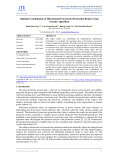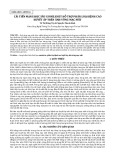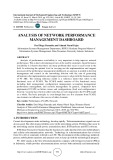
TNU Journal of Science and Technology
229(06): 160 - 169
http://jst.tnu.edu.vn 160 Email: jst@tnu.edu.vn
APPLICATION OF COMBINING DATA PREPROCESSING WITH WAVELET
FILTERING FOR GCN-LSTM NETWORK WITH HHO OPTIMIZATION
ALGORITHM IN LOAD FORECASTING MODEL
Duong Ngoc Hung1,2*, Nguyen Minh Tam1, Nguyen Tung Linh3,
Nguyen Thanh Hoan4, Nguyen Thanh Duy2
1HCM University of Technology and Education, 2Tien Giang University, 3Electric Power University
4Department of Information Technology - Ho Chi Minh Power Corporation (EVNHCMC)
ARTICLE INFO
ABSTRACT
Received:
12/3/2024
Accurate daily load forecasting is critical for effective energy
management planning. In this study, the article proposes a new method
for daily load forecasting that takes advantage of load data and weather
data over time in Tien Giang. The forecast model is improved by
incorporating a data preprocessing Wavelet filter to the graph
convolutional network to combine input data across time points, days
of the year, and other input features. The output of the graph
convolution network is then fed into the Long Short Term Memory
network with an optimization algorithm in the load forecasting model.
The forecasting model is evaluated based on load data from the mini-
grid model in Tien Giang province's power grid, comparing it with
other deep learning-based forecasting models. The results show that the
proposed model outperforms other models in terms of root mean square
error and average absolute percentage error, proving the effectiveness
of the method in terms of reliability and accuracy.
Revised:
23/5/2024
Published:
24/5/2024
KEYWORDS
Graph Convolution Network
Long Short-Term Memory
Load Forecasting
Wavelet filter
Harris hawks optimization
ỨNG DỤNG KẾT HỢP LỌC WAVELET TIỀN XỬ LÝ DỮ LIỆU
CHO MẠNG GCN-LSTM VỚI GIẢI THUẬT TỐI ƯU HÓA HHO
TRONG MÔ HÌNH DỰ BÁO PHỤ TẢI
Dương Ngọc Hùng1,2*, Nguyễn Minh Tâm1, Nguyễn Tùng Linh3,
Nguyễn Thanh Hoan4, Nguyễn Thanh Duy2
1Trường Đại học Sư phạm Kỹ thuật Thành phố Hồ Chí Minh, 2Trường Đại học Tiền Giang, 3Trường Đại học Điện lực
4Công ty Công nghệ thông tin – Tổng Công ty điện lực Thành phố Hồ Chí Minh
THÔNG TIN BÀI BÁO
TÓM TẮT
Ngày nhận bài:
12/3/2024
Dự báo chính xác tải hàng ngày là rất quan trọng để lập kế hoạch quản
lý năng lượng. Trong nghiên cứu này đề xuất phương pháp mới để dự
báo phụ tải hàng ngày tận dụng dữ liệu phụ tải và dữ liệu thời tiết theo
thời gian ở Tiền Giang. Mô hình dự báo được cải thiện bằng cách kết
hợp bộ lọc Wavelet tiền xử lý dữ liệu cho mạng chuyển đổi đồ thị để
kết hợp dữ liệu đầu vào theo các điểm thời gian, ngày trong năm và các
tính năng đầu vào khác. Đầu ra của mạng chuyển đổi đồ thị sau đó được
đưa vào mạng Bộ nhớ ngắn hạn dài với giải thuật tối ưu hoá trong mô
hình dự báo phụ tải. Mô hình dự báo được đánh giá dựa trên dữ liệu phụ
tải từ mô hình lưới điện nhỏ trong lưới điện tỉnh Tiền Giang, so sánh nó
với các mô hình dự báo dựa trên deep learning khác. Kết quả cho thấy
mô hình đề xuất vượt trội hơn về sai số bình phương trung bình gốc và
sai số phần trăm tuyệt đối trung bình, cho thấy hiệu quả của phương
pháp là tin cậy và chính xác.
Ngày hoàn thiện:
23/5/2024
Ngày đăng:
24/5/2024
TỪ KHÓA
Mạng tích chập đồ thị
Bộ nhớ dài – ngắn hạn
Dự báo phụ tải
Bộ lọc Wavelet
Tối ưu hoá HHO
DOI: https://doi.org/10.34238/tnu-jst.9875
* Corresponding author. Email: 1726001@student.hcmute.edu.vn

TNU Journal of Science and Technology
229(06): 160 - 169
http://jst.tnu.edu.vn 161 Email: jst@tnu.edu.vn
1. Introduction
Technology is becoming increasingly pervasive in our lives, leading to a corresponding surge in
the demand for electricity. A novel modeling approach is proposed in this paper for inverter-
dominated microgrids using dynamic phasors in small-scale grids known as microgrids (MGs) [1].
Advanced techniques and tools have been developed for optimal energy operation in microgrid
(MG) models, which are small-scale grids [2]. The significance of consumer load forecasting is
increasingly being highlighted, with load forecasting being considered a more intricate issue than
other forecasting challenges. Precise short-term forecasts can enhance the efficiency and
convenience of power system operations in each area. If the prediction indicates that storage
capacity is insufficient to support future loads, utilities can alert users, prompting them to reduce
their energy consumption. This is crucial since users not only wish to avoid paying more for
conventional energy but also desire to receive preferential treatment from authorities.
The study [3] adopts a hybrid approach for short-term forecasting of load demand in a typical
microgrid (MG) proposed, leveraging the superior capabilities of deep learning. The approach
combines a static wavelet packet transform and a feedforward neural network, which is optimized
using the Harris Hawks Optimization (HHO) Algorithm depicted in the figure. Harris Hawks
Optimization is employed as an alternative training algorithm to optimize the weighted average
and basis of neurons. In the study [4], the next approach was to use the Harris Hawks
Optimization (HHO) algorithm to forecast hourly load demand. To increase the accuracy of the
prediction model, this study used the HHO algorithm to compute in the Wavenet network. In
paper [5], the study investigates the relevance and combination of two deep neural network
architectures: Feed-forward Deep Neural Network (FF-DNN) and Recurrent Deep Neural
Network (R-DNN). Additionally, the study explores the WaveNet approach proposed in [6],
which employs dilating causal complexes and connection skipping to incorporate long-term
information. This innovative machine learning architecture offers several advantages over other
statistical algorithms.
Numerous methods for load forecasting have been proposed by researchers. One such
approach, discussed in [7], involves utilizing a linear approach combined with support vector
machines for robust regression specifically in the application domain of load forecasting. The
SVRCCS model, as proposed in paper [8], utilizes a tent chaotic mapping function to expand the
search space of the cuckoo search algorithm and prevent getting stuck in local optima. Moreover,
to address the cyclic patterns observed in electric loads, the model incorporates a seasonal
mechanism along with the SVRCCS. Furthermore, in paper [9], a new model for short-term load
forecasting is introduced, which relies on the weighted k-nearest neighbor algorithm to achieve
higher accuracy. The model's performance is also compared against the back-propagation neural
network and autoregressive moving average models by examining the forecasting errors.
In order to further advance from ANN, the model proposed in [10] employs an ensemble
model using a novel learning technology known as extreme learning machine (ELM) to enhance
the quality of short-term load forecasting in the Australian National Electricity Market (NEM).
The study [11] applied a Bayesian neural network (BNN) to predict the load. To select the inputs
for the individual BNNs, the sub-series with Euclidean norms closest to the minimum norm were
chosen. In [12], the issue of short-term load forecasting is addressed by utilizing a deep learning
approach called Correlation Sorting-LSTM. This method involves analyzing the correlation
between sub and master tables of smart meters to improve the accuracy of the forecast.
Experiments were conducted in [13] to evaluate the practicality and stability of the proposed
model in a real-world scenario. The forecast accuracy of the model was also compared against
the LSTM and CNN models.
Short-term load forecasting can also be performed using models such as Autoregressive
Integrated Moving Average (ARIMA) [14], seasonal ARIMA (SARIMA) [15], Seasonal

TNU Journal of Science and Technology
229(06): 160 - 169
http://jst.tnu.edu.vn 162 Email: jst@tnu.edu.vn
Autoregressive Moving Average with Exogenous (SARIMAX) [16] and Modified
Autoregressive Moving Averages (ARMA) [17]. However, these methods are not suitable for
handling the non-linear properties of loads and tend to be inaccurate, limiting their applicability
and presenting significant drawbacks.
Researchers regard machine learning and compositing techniques as powerful methods for
addressing the non-linear properties of loads. Among machine learning approaches, Support Vector
Machines (SVMs) and Artificial Neural Networks (ANNs) are commonly used. Both SVM and a
seasonally adjusted SVM-based association model (SSA-SVM) were employed for STLF in studies
[18] – [20]. The authors compared the performance of SSA-SVM against other methods, such as
ANN and seasonally integrated wavelet-based ANN and found that SSA-SVM outperformed them.
Additionally, several combined approaches have also been used for load forecasting.
Several methods have been used for load forecasting, such as Grasshopper Optimization
Algorithm (GOA) based on SVM [21], Genetic Algorithm (GA) combined with SVM [22],
Firefly Algorithm (FFA) SVM [23], [24], Particle Swarm Optimization (PSO) based on Support
Vector Machines (SVM) [25], improved Fruit Fly Optimization Algorithm based on SVM [26],
horizontal migration algorithm (GTA) based on hybrid PSO and SVM [27], experimental
decomposition mode (EMD) [28], and Wavelet Transform (WT) [29] with PSO-SVM.
The machine learning and matching methods, as mentioned in the references, have some
drawbacks, such as the difficulty in selecting parameters and the unclear choice of input
variables. To overcome these challenges, this paper proposes an improved approach for load
forecasting, which combines the Graph Convolutional Network Model (GCN) with LSTM. To
demonstrate the effectiveness of this technique, the proposed method is compared with other
competing models, such as ANN, LSTM, CNN-LSTM, and Wavenet. The rest of the article is
organized as follows: Section 2 provides a detailed description of the GCN combined with LSTM
approach used in the Tensorflow library, while section 3 presents numerical results and images.
Finally, conclusions are provided in the last section.
2. Proposed algorithm and experiments
2.1. Proposed algorithm
2.1.1. Identify problem
In this paper, the forecasting objective is to forecast daily capacity based on historical load
data, weather data in Tien Giang area.
Definition 1: network of data types over time (days) as . To represent the topological
structure of the data network over time points in a year, we use an unweighted graph
treating each time point as a node in the graph. represents the set of time point nodes,
, represents the set of edges and denotes the number of nodes. The adjacency
matrix is used to represent the connection between the lines, . In the adjacency
matrix, the elements can only be 0 or 1. An element with a value of 0 indicates that there is no
association between the time points, while a value of 1 indicates a connection.
Definition 2: feature matrix . In our analysis, we view the data information of a time
point network as an attribute of the network's node. This attribute is denoted as , where
represents the number of node attribute characteristics (length of the history time series) and
is used to represent the load quantities and time-varying factors at time point i. Once
again, the node attribute characteristics can be any type of data information, such as daily load
and weather conditions.
2.1.2. Harris hawks optimization (HHO)
Developed from research results [4] and Figure 1, after configuring the structure of the GCN-
LSTM Network, the weight set of the GCN-LSTM will be adjusted by a training algorithm to

TNU Journal of Science and Technology
229(06): 160 - 169
http://jst.tnu.edu.vn 163 Email: jst@tnu.edu.vn
minimize errors. Therefore, HHO is applied to train GCN-LSTM to achieve high accuracy with
minimal error. The representation of the search agent in the HHO and the appropriate selection of
the objective function are important factors. In HHO-GCN-LSTM, each search agent is formed
by three parts: a set of weight connections between the input layer and the hidden layer, a set of
weights, and a set of weight connections between the hidden layer and the output layer, along
with bias weights. In this work, HHO search agents are encoded as vectors in the interval [-1, 1].
Figure 1. General diagram of HHO method [4]
(a)
(b)
Figure 2. 2D Graph Convolutional: (a) Graph
Convolutional; (b) Topological relationship node
2.1.3. Modeling spatial dependence
Acquiring complex spatial dependencies is a significant challenge in load forecasting.
Traditional convolutional neural networks (CNNs) can capture local spatial features, but they are
only effective in Euclidean space, such as images, regular meshes, and so on. However, the day-
of-year point network is graph-based, not a two-dimensional grid. This means that the CNN
model cannot effectively represent the complex topological structure of the time point network
and thus cannot accurately capture the spatial dependencies. Recently, there has been significant
interest in integrating CNNs into graph convolutional networks (GCNs), which can process data
with arbitrary graph structures. The GCN model has been successfully applied in many areas,
including document classification [18], unsupervised learning [30], and image classification [31].
The GCN model constructs a filter in the Fourier domain that operates on the nodes of the graph
and their first-order neighborhood to capture the spatial features between nodes. The GCN model
can then be constructed by stacking multiple layers of complexity. As shown in Figure 2, the
GCN model can obtain the topological relationship between the centerline and the surrounding
paths, encode the topological structure of the time point network and the data attributes, and then
capture the spatial dependencies. In summary, we use the GCN model [31] to learn spatial
features from the data over time.
The 2-layer GCN model can be expressed as follows:
( ( ))
represents the feature matrix, represents the adjacency matrix,
represents
the preprocessing step, is the self-connecting structure matrix, is the order
matrix, . and represents the weight matrix in the first layer, and second, and
, represents the activation function.

TNU Journal of Science and Technology
229(06): 160 - 169
http://jst.tnu.edu.vn 164 Email: jst@tnu.edu.vn
2.1.5. Time graph transformation network
We introduce a time graph convolutional network (T-GCN) model that combines a graph
convolutional network and periodic units to capture both spatial and temporal dependencies in
load data. The load prediction process and the specific structure of a T-GCN cell are illustrated in
Figure 3, represents the output at time , the GC is graph convolution, and , are the
update and reset gates at time and represents the output at time
XtX tht-1
htYt
GCN
ut
rt
ct
Model of 1 T-GCN cell
Figure 3. The specific architecture of a T-GCN unit
Xt-2 Xt-1 Xt
Yt-2 Yt-1 Yt
TGCN TGCN TGCN
ht-2 ht-1
Deep learning network model
Figure 4. The specific architecture of deep learning
network model with the convolution of the graph [32]
The overall network layer structure is GCN-LSTM, within which the filtered data is
reconstructed into data arrays comprising power output data, temperature data, and time encoding
codes. In Figure 4, each time series data array is fed into each symbolic network layer Xt-2, Xt-1, Xt.
Input data Xt undergoes graph convolution to produce X’t, and the result X’t is combine with ht-1
(the results obtained from the previous network layer). In this phase, the program determines the
full structure of the GCN-LSTM network model and initial initialization parameters for training.
Therefore, the problem of load forecasting based on non-time characteristics can be viewed as
learning the mapping function f based on the network structure and feature matrix.
X is computed by using the inputs of historical load data, weather data for the next T time
points, as shown in Equation 2:
[ ] ( )
where is the length of the historical time series and is the length of the time series to be
predicted.
2.1.6. Data filter based on Wavelet transform
Through electricity load surveys in the Tien Giang area, sudden changes often appear and
create disturbances when observing the past database. Therefore, assessing the reliability of this
data set will be essential in the data processing stage before entering load forecasting models to
produce forecasting results. In this paper, the author uses a data filter application that considers
the reliability of the data source by analyzing many different levels of reliability and using the
HHO-GCN-LSTM model.
2.1.7. Wavelet Filter Model – HHO – GCN – LSTM
Raw data including power output data collected in Tien Giang after passing through the filter
and temperature data are fed into the training network using the HHO-GCN-LSTM model.
Through Figure 5, to perform the network training phase according to the HHO-GCN-LSTM
model, follow the following steps:
Step 1: First, the program initializes the structure of the GCN-LSTM network layers. Each
GCN-LSTM (TGCN) element is built as shown in Figure 5.
Step 2: The training process is performed with computational loops to update the parameters
of the GCN-LSTM network model. In this study, the calculation to achieve convergence of
parameters in each iteration uses the HHO optimization algorithm. This process is symbolically
shown in the diagram figure 5 including:


























